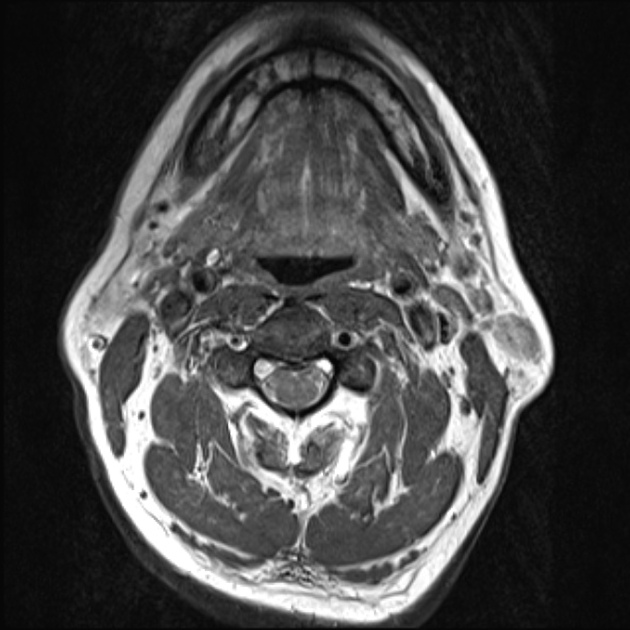Papillary thyroid cancer MRI: Difference between revisions
Jump to navigation
Jump to search
No edit summary |
No edit summary |
||
| Line 3: | Line 3: | ||
{{CMG}}; {{AE}} {{Ammu}} | {{CMG}}; {{AE}} {{Ammu}} | ||
==Overview== | ==Overview== | ||
MRI may be helpful in the diagnosis of papillary thyroid cancer. MRI may also be performed to detect metastases of papillary thyroid cancer to brain and bones. | |||
==Key CT or MRI Findings in Papillary thyroid cancer== | ==Key CT or MRI Findings in Papillary thyroid cancer== | ||
* MRI, although probably more sensitive that CT, is nonetheless still far from perfect with a sensitivity of only 67% 2. This is largely a result of the fact that as many as half involved nodes found histologically following surgery, being less than 3 mm in diameter 2. | * MRI, although probably more sensitive that CT, is nonetheless still far from perfect with a sensitivity of only 67% 2. This is largely a result of the fact that as many as half involved nodes found histologically following surgery, being less than 3 mm in diameter 2. | ||
Revision as of 21:26, 5 November 2015
|
Papillary thyroid cancer Microchapters |
|
Differentiating Papillary thyroid cancer from other Diseases |
|---|
|
Diagnosis |
|
Treatment |
|
Case Studies |
|
Papillary thyroid cancer MRI On the Web |
|
American Roentgen Ray Society Images of Papillary thyroid cancer MRI |
|
Risk calculators and risk factors for Papillary thyroid cancer MRI |
Editor-In-Chief: C. Michael Gibson, M.S., M.D. [1]; Associate Editor(s)-in-Chief: Ammu Susheela, M.D. [2]
Overview
MRI may be helpful in the diagnosis of papillary thyroid cancer. MRI may also be performed to detect metastases of papillary thyroid cancer to brain and bones.
Key CT or MRI Findings in Papillary thyroid cancer
- MRI, although probably more sensitive that CT, is nonetheless still far from perfect with a sensitivity of only 67% 2. This is largely a result of the fact that as many as half involved nodes found histologically following surgery, being less than 3 mm in diameter 2.
- As discussed above, nodes have a tendency to become cystic. The cystic component will have near-fluid attenuation. The solid metastatic component will appear 2:
- General signal characteristics include:
- T1
- hypointense cf. muscle
- enhancement best seen with fat suppression
- T2: variable 2
- Hypointense: 34%
- Isointense: 45%
- Hyperintense: 21%
CT or MRI Examples of Papillary thyroid cancer

References
- ↑ Image courtesy of Dr Ian Bickle. Radiopaedia (original file ‘’here’’.Creative Commons BY-SA-NC